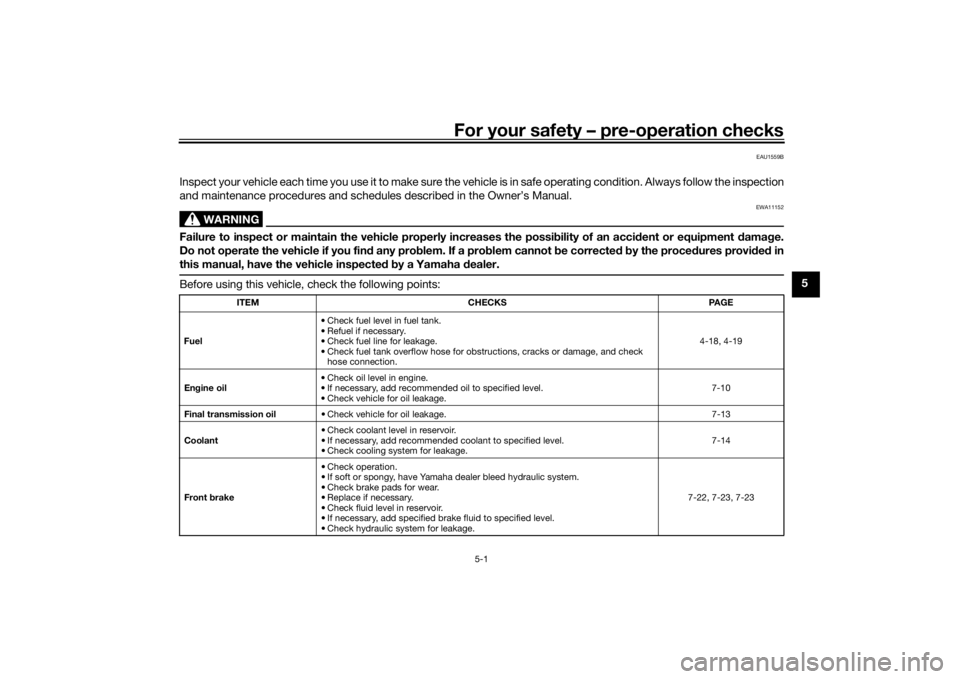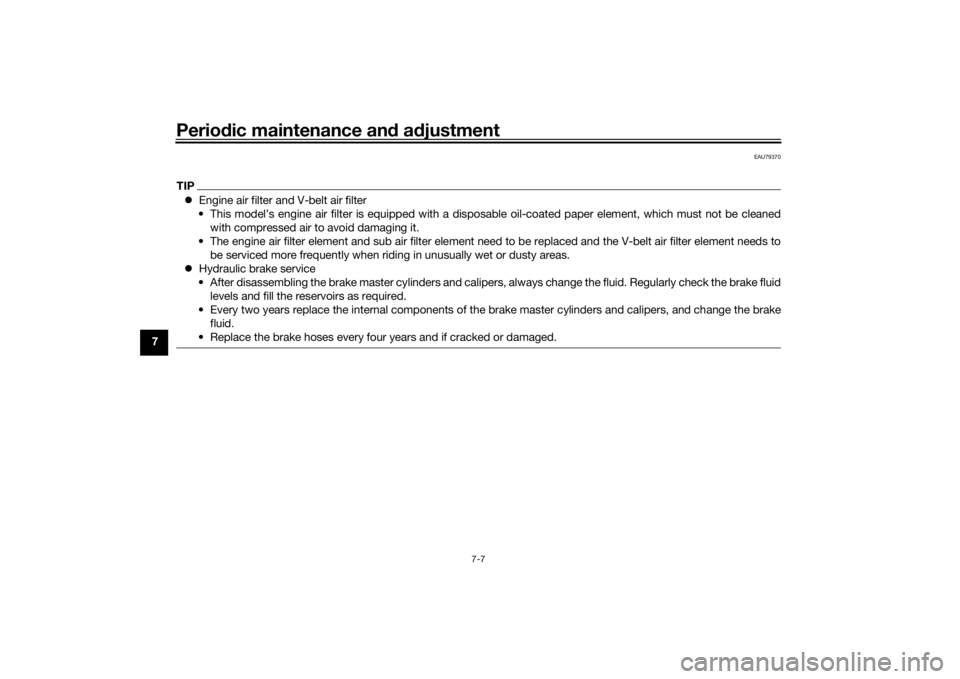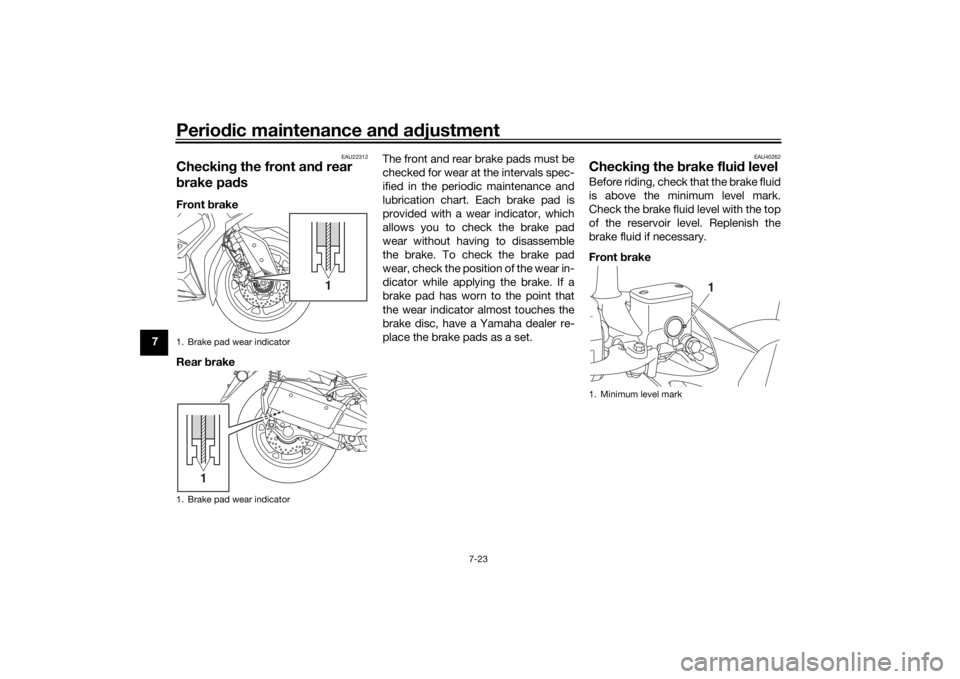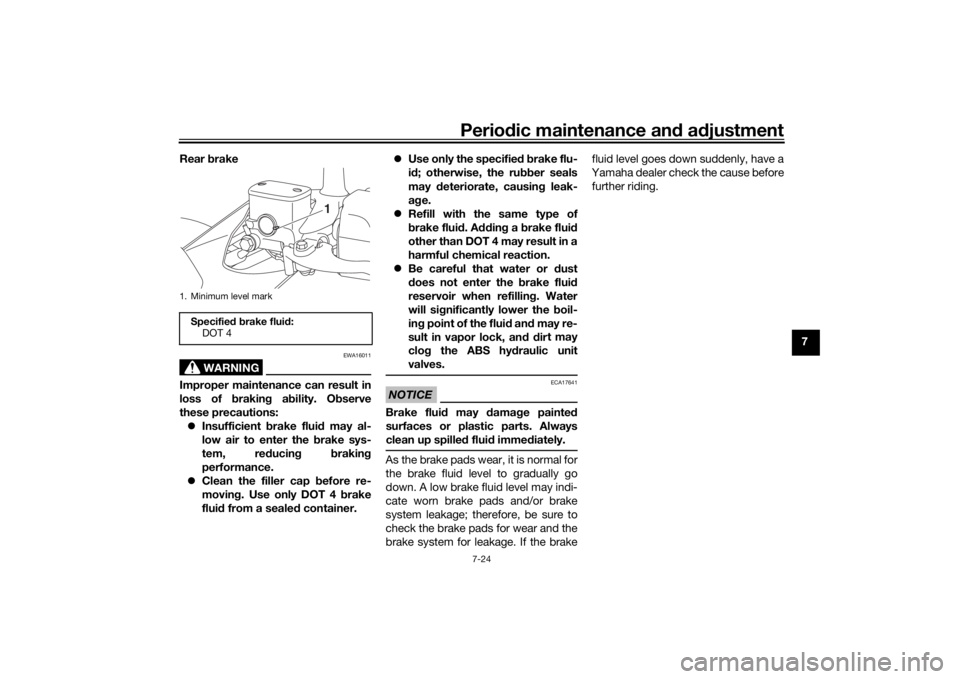brake fluid YAMAHA XMAX 300 2022 Owners Manual
[x] Cancel search | Manufacturer: YAMAHA, Model Year: 2022, Model line: XMAX 300, Model: YAMAHA XMAX 300 2022Pages: 116, PDF Size: 4.64 MB
Page 8 of 116

Table of contentsSafety information ............................ 1-1
Further safe-riding points ............... 1-5
Description ....................................... 2-1
Left view ......................................... 2-1
Right view ....................................... 2-2
Controls and instruments ............... 2-3
Smart key system ........................... 3-1
Smart key system ........................... 3-1
Operating range of the smart key system......................................... 3-2
Handling of the smart key and mechanical keys ......................... 3-3
Smart key ....................................... 3-5
Replacing the smart key battery..... 3-6
Main switch .................................... 3-8
Instrument an d control functions ... 4-1
Indicator lights and warning
lights............................................ 4-1
Speedometer .................................. 4-3
Tachometer .................................... 4-3
Multi-function display ..................... 4-4
Handlebar switches ...................... 4-12
Front brake lever .......................... 4-13
Rear brake lever ........................... 4-14
Anti-lock brake system (ABS)....... 4-14
Traction control system ................ 4-15
Fuel tank cap ................................ 4-17
Fuel ............................................... 4-18 Fuel tank overflow hose ................ 4-19
Catalytic converter ........................ 4-20
Storage compartments ................. 4-20
Windshield .................................... 4-22
Handlebar position ....................... 4-24
Adjusting the shock absorber
assemblies ................................. 4-25
Auxiliary DC jack .......................... 4-25
Sidestand ...................................... 4-26
Ignition circuit cut-off system ....... 4-27
For your safety – pre-operation
checks ............................................... 5-1
Operation an d important ri din g
points ................................................. 6-1
Engine break-in ............................... 6-1
Starting the engine .......................... 6-2
Starting off ...................................... 6-3
Acceleration and deceleration ........ 6-3
Braking ............................................ 6-3
Tips for reducing fuel consumption ................................ 6-4
Parking ............................................ 6-4
Perio dic maintenance an d
a d justment ........................................ 7-1
Tool kit ............................................ 7-2
Periodic maintenance charts .......... 7-3
Periodic maintenance chart for the emission control system .............. 7-3 General maintenance and
lubrication chart .......................... 7-4
Removing and installing the panel............................................ 7-8
Checking the spark plug................. 7-9
Canister ........................................ 7-10
Engine oil and oil filter element..... 7-10
Final transmission oil .................... 7-13
Coolant ......................................... 7-14
Air filter and V-belt case air filter elements .................................... 7-15
Checking the throttle grip free play ............................................ 7-19
Valve clearance............................. 7-20
Tires .............................................. 7-20
Cast wheels .................................. 7-22
Checking the front and rear
brake lever free play .................. 7-22
Checking the front and rear brake pads ................................ 7-23
Checking the brake fluid level ...... 7-23
Changing the brake fluid .............. 7-25
Checking the V-belt ...................... 7-25
Checking and lubricating the cables ........................................ 7-25
Checking and lubricating the
throttle grip and cable ............... 7-26
Lubricating the front and rear brake levers ............................... 7-26
Checking and lubricating the centerstand and sidestand........ 7-27UBBAE1E0.book Page 1 Monday, October 4, 2021 4:51 PM
Page 18 of 116

Description
2-3
2
EAU10431
Controls and instruments
10
11
121
2
3
9
8
7
5
6
4
1. Rear brake lever (page 4-14)
2. Left handlebar switches (page 4-12)
3. Rear brake fluid reservoir (page 7-23)
4. Speedometer (page 4-3)
5. Multi-function display (page 4-4)
6. Tachometer (page 4-3)
7. Front brake fluid reservoir (page 7-23)
8. Right handlebar switches (page 4-12) 9. Front brake lever (page 4-13)
10.Throttle grip (page 7-19)
11.Main switch (page 3-8)
12.Auxiliary DC jack (page 4-25)UBBAE1E0.book Page 3 Monday, October 4, 2021 4:51 PM
Page 59 of 116

For your safety – pre-operation checks
5-1
5
EAU1559B
Inspect your vehicle each time you use it to make sure the vehicle is in safe operating condition. Always follow the inspection
and maintenance procedures and schedules described in the Owner’s Manual.
WARNING
EWA11152
Failure to inspect or maintain the vehicle properly increases the possibility of an acci dent or equipment damag e.
Do not operate the vehicle if you fin d any pro blem. If a pro blem cannot be corrected b y the proce dures provi ded in
this manual, have the vehicle inspecte d b y a Yamaha dealer.Before using this vehicle, check the following points:
ITEM CHECKS PAGE
Fuel • Check fuel level in fuel tank.
• Refuel if necessary.
• Check fuel line for leakage.
• Check fuel tank overflow hose for obstructions, cracks or damage, and check
hose connection. 4-18, 4-19
En gine oil • Check oil level in engine.
• If necessary, add recommended oil to specified level.
• Check vehicle for oil leakage. 7-10
Final transmission oil • Check vehicle for oil leakage. 7-13
Coolant • Check coolant level in reservoir.
• If necessary, add recommended coolant to specified level.
• Check cooling system for leakage. 7-14
Front brake • Check operation.
• If soft or spongy, have Yamaha dealer bleed hydraulic system.
• Check brake pads for wear.
• Replace if necessary.
• Check fluid level in reservoir.
• If necessary, add specified brake fluid to specified level.
• Check hydraulic system for leakage. 7-22, 7-23, 7-23
UBBAE1E0.book Page 1 Monday, October 4, 2021 4:51 PM
Page 60 of 116

For your safety – pre-operation checks
5-2
5
Rear brake • Check operation.
• If soft or spongy, have Yamaha dealer bleed hydraulic system.
• Check brake pads for wear.
• Replace if necessary.
• Check fluid level in reservoir.
• If necessary, add specified brake fluid to specified level.
• Check hydraulic system for leakage. 7-22, 7-23, 7-23
Throttle g rip • Make sure that operation is smooth.
• Check throttle grip free play.
• If necessary, have Yamaha dealer adjust throttle grip free play and lubricate ca-
ble and grip housing. 7-19, 7-26
Control ca bles • Make sure that operation is smooth.
• Lubricate if necessary. 7-25
Wheels an d tires •Check for damage.
• Check tire condition and tread depth.
• Check air pressure.
• Correct if necessary. 7-20, 7-22
Brake levers • Make sure that operation is smooth.
• Lubricate lever pivoting points if necessary.
7-26
Centerstan d, si destan d • Make sure that operation is smooth.
• Lubricate pivots if necessary.
7-27
Chassis fasteners • Make sure that all nuts, bolts and screws are properly tightened.
• Tighten if necessary. —
Instruments, li ghts, si gnals
an d switches • Check operation.
• Correct if necessary.
—
Si destan d switch • Check operation of ignition circuit cut-off system.
• If system is not working correctly, have Yamaha dealer check vehicle.
4-26
ITEM
CHECKS PAGE
UBBAE1E0.book Page 2 Monday, October 4, 2021 4:51 PM
Page 69 of 116

Periodic maintenance an d a djustment
7-4
7
EAU71353
General maintenance an d lu brication chartNO. ITEM CHECK OR MAINTENANCE JOB ODOMETER READING
ANNUAL
CHECK
1000 km
(600 mi) 10000 km
(6000 mi) 20000 km
(12000 mi) 30000 km
(18000 mi) 40000 km
(24000 mi)
1 *Dia
gnostic system
check • Perform dynamic inspection us-
ing Yamaha diagnostic tool.
• Check the error codes. √√√√√√
2 *Air filter element •Replace. √√
3 *Pre air filter element • Clean. √√
4 *Su
b air filter ele-
ment •Replace.
√√
5 Air filter case check
hose
• Clean.
√√√√√
6 *V-
belt case air filter
element • Clean.
• Replace if necessary.
√√√√√
7 *Front brake • Check operation, fluid level, and
for fluid leakage.
• Replace brake pads if necessary. √√√√√√
8 *Rear brake • Check operation, fluid level, and
for fluid leakage.
• Replace brake pads if necessary. √√√√√√
9 *Brake hoses • Check for cracks or damage.
√√√√√
• Replace. Every 4 years
10 *Brake flui d • Change. Every 2 years
11 *Wheels • Check runout and for damage.
• Replace if necessary. √√√√
UBBAE1E0.book Page 4 Monday, October 4, 2021 4:51 PM
Page 72 of 116

Periodic maintenance an d a djustment
7-7
7
EAU79370
TIP Engine air filter and V-belt air filter
• This model’s engine air filter is equipped with a disposable oil-coated paper element, which must not be cleaned with compressed air to avoid damaging it.
• The engine air filter element and sub air filter element need to be replaced and the V-belt air filter element needs to be serviced more frequently when riding in unusually wet or dusty areas.
Hydraulic brake service
• After disassembling the brake master cylinders and calipers, always change the fluid. Regularly check the brake fluid levels and fill the reservoirs as required.
• Every two years replace the internal components of the brake master cylinders and calipers, and change the brake fluid.
• Replace the brake hoses every four years and if cracked or damaged.
UBBAE1E0.book Page 7 Monday, October 4, 2021 4:51 PM
Page 88 of 116

Periodic maintenance an d a djustment
7-23
7
EAU22312
Checkin g the front an d rear
b rake pa dsFront brake
Rear brake The front and rear brake pads must be
checked for wear at the intervals spec-
ified in the periodic maintenance and
lubrication chart. Each brake pad is
provided with a wear indicator, which
allows you to check the brake pad
wear without having to disassemble
the brake. To check the brake pad
wear, check the position of the wear in-
dicator while applying the brake. If a
brake pad has worn to the point that
the wear indicator almost touches the
brake disc, have a Yamaha dealer re-
place the brake pads as a set.
EAU40262
Checkin
g the brake flui d levelBefore riding, check that the brake fluid
is above the minimum level mark.
Check the brake fluid level with the top
of the reservoir level. Replenish the
brake fluid if necessary.
Front brake
1. Brake pad wear indicator
1. Brake pad wear indicator
1
1
1. Minimum level mark
1
UBBAE1E0.book Page 23 Monday, October 4, 2021 4:51 PM
Page 89 of 116

Periodic maintenance an d a djustment
7-24
7
Rear
brake
WARNING
EWA16011
Improper maintenance can result in
loss of b raking a bility. O bserve
these precautions: Insufficient brake flui d may al-
low air to enter the brake sys-
tem, re ducin g brakin g
performance.
Clean the filler cap before re-
movin g. Use only DOT 4 brake
flui d from a seale d container.
Use only the specified b rake flu-
i d ; otherwise, the ru bber seals
may deteriorate, causin g leak-
a g e.
Refill with the same type of
brake flui d. A dding a brake fluid
other than DOT 4 may result in a
harmful chemical reaction.
Be careful that water or d ust
d oes not enter the brake flui d
reservoir when refillin g. Water
will si gnificantly lower the boil-
in g point of the flui d an d may re-
sult in vapor lock, an d d ir
t may
clo g the ABS hy draulic unit
valves.
NOTICE
ECA17641
Brake flui d may d amage painte d
surfaces or plastic parts. Always
clean up spilled fluid imme diately.As the brake pads wear, it is normal for
the brake fluid level to gradually go
down. A low brake fluid level may indi-
cate worn brake pads and/or brake
system leakage; therefore, be sure to
check the brake pads for wear and the
brake system for leakage. If the brake fluid level goes down suddenly, have a
Yamaha dealer check the cause before
further riding.
1. Minimum level markSpecifie
d b rake flui d:
DOT 4
1
UBBAE1E0.book Page 24 Monday, October 4, 2021 4:51 PM
Page 90 of 116

Periodic maintenance an d a djustment
7-25
7
EAU22734
Chan gin g the brake flui dHave a Yamaha dealer change the
brake fluid every 2 years. In addition,
have the seals of the master cylinders
and brake calipers, as well as the brake
hoses replaced at the intervals listed
below or sooner if they are damaged or
leaking.
Brake seals: every 2 years
Brake hoses: every 4 years
EAUU0311
Checkin g the V- beltThe V-belt must be checked and re-
placed by a Yamaha dealer at the inter-
vals specified in the periodic
maintenance and lubrication chart.
EAU23098
Checkin g an d lu bricatin g the
cab lesThe operation of all control cables and
the condition of the cables should be
checked before each ride, and the ca-
bles and cable ends should be lubri-
cated if necessary. If a cable is
damaged or does not move smoothly,
have a Yamaha dealer check or re-
place it. WARNING! Dama ge to the
outer housin g of cab les may result
in internal rustin g an d cause inter-
ference with cab le movement. Re-
place damag ed cab les as soon as
possi ble to prevent unsafe con di-
tions.
[EWA10712]
Recommen ded lu bricant:
Yamaha cable lubricant or other
suitable cable lubricant
UBBAE1E0.book Page 25 Monday, October 4, 2021 4:51 PM
Page 113 of 116

11-1
11
Index
AABS warning light ................................... 4-2
Acceleration and deceleration ................ 6-3
Air filter and V-belt case air filter
elements ............................................. 7-15
Anti-lock brake system (ABS)............... 4-14
Auxiliary DC jack .................................. 4-25
Auxiliary lights....................................... 7-32BBattery .................................................. 7-29
Brake fluid, changing............................ 7-25
Brake fluid level, checking.................... 7-23
Brake lever, front .................................. 4-13
Brake lever, rear ................................... 4-14
Brake levers, lubricating ....................... 7-26
Brake/tail light....................................... 7-32
Braking ................................................... 6-3CCables, checking and lubricating ......... 7-25
Canister ................................................ 7-10
Care ........................................................ 8-1
Catalytic converter ............................... 4-20
Centerstand and sidestand,
checking and lubricating .................... 7-27
Coolant ................................................. 7-14DData recording, vehicle......................... 10-2
Diagnostic connector ........................... 10-2
Dimmer/Pass switch............................. 4-12EEmergency mode ................................. 7-37
Engine break-in ...................................... 6-1
Engine oil and oil filter element............. 7-10
Engine overheating ............................... 7-36 Engine serial number ........................... 10-1
FFinal transmission oil............................ 7-13
Front and rear brake lever free play,
checking ............................................ 7-22
Front and rear brake pads, checking ... 7-23
Front fork, checking ............................. 7-27
Front turn signal light ........................... 7-32
Fuel ...................................................... 4-18
Fuel consumption, tips for reducing ...... 6-4
Fuel tank cap........................................ 4-17
Fuel tank overflow hose ....................... 4-19
Fuses, replacing ................................... 7-30HHandlebar position, adjusting .............. 4-24
Handlebar switches ............................. 4-12
Hazard switch ...................................... 4-13
Headlights ............................................ 7-31
High beam indicator light ....................... 4-1
Horn switch .......................................... 4-12IIdentification numbers ......................... 10-1
Ignition circuit cut-off system .............. 4-27
Indicator lights and warning lights ......... 4-1KKey, handling of smart and mechanical keys .................................. 3-3LLicense plate light bulb, replacing ....... 7-33MMain switch ............................................ 3-8
Maintenance and lubrication, periodic... 7-4
Maintenance, emission control system ................................................. 7-3 Malfunction indicator light (MIL) ............. 4-1
Matte color, caution................................ 8-1
Model label ........................................... 10-1
Multi-function display ............................. 4-4
OOperating range of the smart key
system .................................................. 3-2PPanel, removing and installing ................ 7-8
Parking.................................................... 6-4
Part locations.......................................... 2-1SSafe-riding points ................................... 1-5
Safety information................................... 1-1
Shock absorber assemblies, adjusting ............................................. 4-25
Sidestand.............................................. 4-26
Smart key................................................ 3-5
Smart key battery, replacing................... 3-6
Smart key system ................................... 3-1
Smart key system indicator light ............ 4-2
Smart key system, troubleshooting ...... 7-34
Spark plug, checking .............................. 7-9
Specifications ......................................... 9-1
Speedometer .......................................... 4-3
Starting off .............................................. 6-3
Starting the engine ................................. 6-2
Steering, checking ................................ 7-28
Stop/Run/Start switch .......................... 4-13
Storage ................................................... 8-3
Storage compartments ......................... 4-20TTachometer............................................. 4-3
UBBAE1E0.book Page 1 Monday, October 4, 2021 4:51 PM